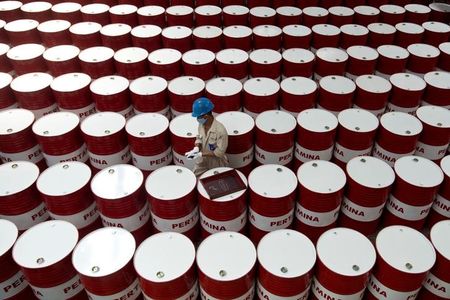Commodities
Oil prices settle higher, but fall to heavy weekly losses on rate, demand jitters

Investing.com– Oil prices settled higher Friday, but that did little to prevent heavy weekly losses Friday as concerns over sticky inflation and high interest rates spurred doubts that demand will remain robust this year.
At 14:30ET (18:30 GMT), rose 1% to $82.14 a barrel, but posted losses of about 2% for the week. While rose 1.1% to $77.74 a barrel, but still slipped to a more than 2% loss for the week.
Oil heads for weekly losses as rate jitters weigh
Both contracts were set to lose around 4% this week, with Brent at its weakest level in two months and WTI at a three-month low. Pressure has come chiefly from concerns over sticky U.S. inflation and the potential for interest rates remaining elevated for a long time.
A string of signals from the Federal Reserve reflected increased anxiety among policymakers that inflation will be slow in reaching the central bank’s 2% annual target – a scenario that is expected to push the central bank into keeping rates high.
Analysts at Goldman Sachs have pushed back when they expect the Federal Reserve to cut interest rates this year, citing comments from central bank officials this week calling for more evidence that inflation in the world’s largest economy is sustainably cooling down to their 2% target.
In a note to clients on Friday, Goldman Sachs analysts said they now do not expect the Fed to roll out a rate cut until September. They had previously estimated that the reduction — which would be the first since the Fed embarked on a steep run of policy tightening in 2022 — would come in July.
The tool now shows a nearly equal probability of a cut or a hold in September.
Baker Hughes rig unchanged
Oilfield services firm Baker Hughes reported Friday its weekly U.S. rigs were unchanged at 497. The ongoing lull in drilling activity hasn’t done much to dent domestic output, which remains near record highs at 13.1 million barrels per day. That is above the average of 12.936 million barrels a day seen last year.
In a trend that has stoked fears of non-OPOC-led oversupply, the U.S. has led global oil production for six years in a row. OPEC and its allies, OPEC+, have attempted to curb global supply through a agreements that seek to limit output of member countries.
OPEC+ meeting in focus for more supply cues
Markets were now looking to a meeting of the Organization of Petroleum Exporting Countries and allies (OPEC+), which is set for the start of June.
Focus will be largely on whether the cartel will extend voluntary production cuts totalling about 2.2 million barrels per day past an end-June deadline.
These voluntary cuts from the cartel of major producers come on top of earlier reductions of 3.66 million barrels per day that were announced in various steps since late 2022 and which are valid until the end of 2024.
Total pledged cuts therefore currently amount to 5.86 million barrels per day, equal to about 5.7% of daily world demand.
But just how tight markets will be this year remains uncertain, especially as production remained at record highs.
Some easing tensions in the Middle East also pointed to fewer supply disruptions for crude, while U.S. oil demand is expected to pick up in the coming weeks with the travel-heavy summer season. The Memorial Day weekend holiday usually marks the beginning of the season, with gasoline demand already seen picking up in the world’s biggest fuel consumer.
(Peter Nurse, Ambar Warrick contributed to this article.)
Commodities
Oil prices rise; U.S. crude inventories plunge, Russia-Ukraine truce eyed
Commodities
India’s Reliance to stop buying Venezuelan oil over US tariffs, sources say
Commodities
Oil prices climb on Venezuela supply worries

 Forex3 years ago
Forex3 years agoForex Today: the dollar is gaining strength amid gloomy sentiment at the start of the Fed’s week

 Forex3 years ago
Forex3 years agoUnbiased review of Pocket Option broker

 Forex3 years ago
Forex3 years agoDollar to pound sterling exchange rate today: Pound plummeted to its lowest since 1985

 Forex3 years ago
Forex3 years agoHow is the Australian dollar doing today?

 Cryptocurrency3 years ago
Cryptocurrency3 years agoWhat happened in the crypto market – current events today

 World3 years ago
World3 years agoWhy are modern video games an art form?

 Commodities3 years ago
Commodities3 years agoCopper continues to fall in price on expectations of lower demand in China

 Economy3 years ago
Economy3 years agoCrude oil tankers double in price due to EU anti-Russian sanctions























